Written by: Amaan Javed
Decisions…decisions…decisions. We make thousands of decisions everyday. In fact, according to a study conducted by UNC TV, the average person makes approximately 226.7 choices daily on food alone (How Many Daily Decisions Do We Make?). That brings up the question, what dictates whether or not a decision made regarding one’s diet and nutrition is a good one and how do we classify one food as being better than another? Is there a grading system or is it solely based on the satisfaction we get from eating the food? In this blog, I will be focusing on my top 3 best fruits and vegetables along with their nutritional values, tastes and flavours, and honorable mentions. It is important to note that this list is not in any particular order and there are many other great foods which are not included in this blog post.
Sweet Potatoes:
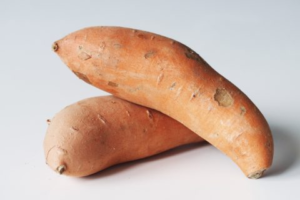
When many of us hear the name of this vegetable, we instantly are reminded of thanksgiving dinner! But the truth is that this food is packed with vitamins and nutrients that make it an amazing choice to incorporate it into our daily diet. Below, I have listed some interesting facts about this potato:
- One sweet potato has 400% of the daily amount of Vitamin A needed (Pathak)
- Rich in Vitamin C, Vitamin D, Calcium, Iron, Magnesium, Zinc etc. (Pathak)
- May help with diabetes, cancer, heart disease, macular degeneration etc. (Pathak)
The sweet potato can vary in taste based on the way it is prepared, for example, a baked potato will taste quite different from a cooked potato. All in all, this particular food has a sweet, yet starchy taste. That being said, this makes the potato an amazing ingredient for preparing many different styles of dishes. Two of my personal favourite recipes include:
Obe Ata Stew With Chicken And Spinach 
Recipe: https://www.bonappetit.com/recipe/obe-ata-stew-with-chicken-and-spinach
Black Lentil and Harissa Veggie Bowl Recipe
Recipe: https://www.bonappetit.com/recipe/black-lentil-and-harissa-roasted-veggie-bowl
When it comes to growing your own sweet potatoes, there are many crucial steps to follow and things to consider. Firstly, you want to dig a long and wide hole with 10 inch high ridges that are 3.5 feet apart (The Editors). A 10 foot row produces 8 to 10 pounds of potatoes. You are going to want to plant root sprouts, also known as slips, available through online suppliers or nurseries. Approximately 6 weeks prior to planting the roots, store them in a box of moist sand, sawdust, or chopped leaves in 75 to 80 degrees temperature. The potatoes will take 90 to 170 days to mature and are extremely frost sensitive.
Avocados:
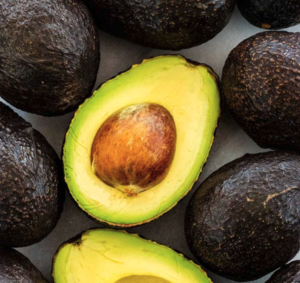
Avocados are a fruit which are often looked at as a superfood, primarily because of the many health benefits which they can bring along. Not to mention, they have an amazing taste! To begin, lets go over some of the nutritional and health value which this superfood holds:
- 26% of Daily Value Vitamin K, 20% of DV folate, 17% of DV Vitamin C, 14% of DV Potassium (Gunnars)
- A 100 gram serving of avocado contains 7 grams of fiber, 27% of RDA (Gunnars)
- May help relieve symptoms of arthritis (Gunnars)
Ripe avocados have a very soft texture that melts inside your mouth, leaving a very rich and slightly sweet taste on your tongue. In addition to this flavour, the fact that the fats in avocado are resistant to heat-induced oxidation make it a great cooking ingredient (Gunnars)! One of my favourite foods that are made from avocado include avocado toast. So simple, yet so packed with flavour. Also, it only takes a few minutes to make. There are many variations as to what you can put on your toast, but I have linked my favourite recipe below.
Avocado Toast – With Variations 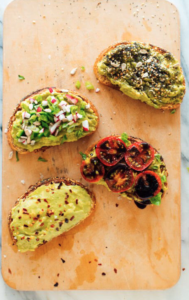
Recipe: https://cookieandkate.com/avocado-toast-recipe/
Growing your own avocado in your home is a very fulfilling and enjoyable, yet very easy, task which anyone can do! I remember doing this with my mother when I was younger. The steps which I took were:
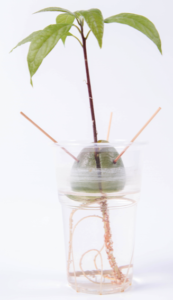
- Remove and clean the pit (Mark)
- Poke 3 holes with a toothpick (Mark)
- Place the seed half submerged in a glass of water (Mark)
- Place in soil when the tree is 15 cm long (Mark)
- Provide sufficient amount of water and sunlight for growth (Mark)
Blueberries:
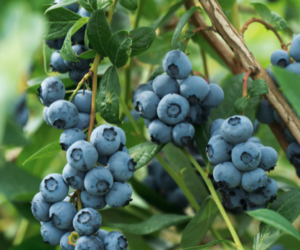
Oh blueberries! These berries are full of flavour, easy to take around as a snack, and an amazing ingredient for many different dishes! Not only this, but they also have many researched benefits. In fact, one cup of these berries:
- Contains 4 grams Fiber, 24% RDI of Vitamin C, 36% RDI of Vitamin K, 25% RDI of manganese (Leech)
- Can reduce DNA damage and prevent heart disease (Leech)
- May lower blood pressure (Leech)
Blueberries are also one of my favorite fruits! They can taste very sweet yet acidic at the same time, perfect for a little snack. Some of my favourite recipes are:
Mini Blueberry Tarts 
Recipe: https://www.tasteofhome.com/recipes/mini-blueberry-tarts/
Blueberry Romaine Salad
Recipe: https://www.tasteofhome.com/recipes/blueberry-romaine-salad/
Creamy Layered Blueberry Ice Pops
Recipe: https://www.tasteofhome.com/recipes/creamy-layered-blueberry-ice-pops/
The best season to plant blueberries is spring and sometimes even late fall (Old Farmer’s Almanac). To begin, select a sunny and sheltered spot where the plant cannot be exposed to harsh winds. Blueberries thrive in acidic environments, preferably between a pH of 4.0 and 5.0. Once you have selected a location, dig holes 20 inches deep and 18 inches wide and then plant the seeds. A month after planting, apply fertilizer to the seeds. Make sure to utilize organic fertilizers as they hold benefits for the soil such as improving texture and increasing bacterial and fungal activity.
Conclusion:
Although I consider these 3 fruits and vegetables as the best, you may have a completely different set of foods which may fit in your top 3. Some of the honourable mentions for this list include broccoli, bananas, raspberries, carrots, and apples. Therefore, it is evident that the value of a fruit/vegetable ranges far more beyond the possible biased connotations associated with it. Instead, it is crucial to analyze fruits and vegetables from a perspective which is inclusive of factors such as nutritional value, cultivation processes, and possible environmental impacts. Thank you for reading!
Works Cited:
Mark Roper. “How to Grow an Avocado from Seed.” Homes To Love, Homes To Love, 4 Feb. 2021, www.homestolove.com.au/grow-an-avocado-from-seed-10585.
The Editors. “Everything You Need to Know to Grow Sweet Potatoes in Your Backyard.” Good Housekeeping, 13 Mar. 2021, www.goodhousekeeping.com/home/gardening/a20706654/how-to-grow-sweet-potatoes/.
Gunnars, Kris. “12 Proven Health Benefits of Avocado.” Healthline, Healthline Media, 29 June 2018, www.healthline.com/nutrition/12-proven-benefits-of-avocado#TOC_TITLE_HDR_2.
“How Many Daily Decisions Do We Make?” UNC, 2018, science.unctv.org/content/reportersblog/choices.
Leech, Joe. “10 Proven Health Benefits of Blueberries.” Healthline, Healthline Media, 9 Oct. 2018, www.healthline.com/nutrition/10-proven-benefits-of-blueberries#TOC_TITLE_HDR_6.
Old Farmer’s Almanac. “Blueberries.” Old Farmer’s Almanac, 2019, www.almanac.com/plant/blueberries.
Pathak, Neha. “Sweet Potato Health Benefits.” WebMD, WebMD, 2019, www.webmd.com/food-recipes/benefits-sweet-potatoes.

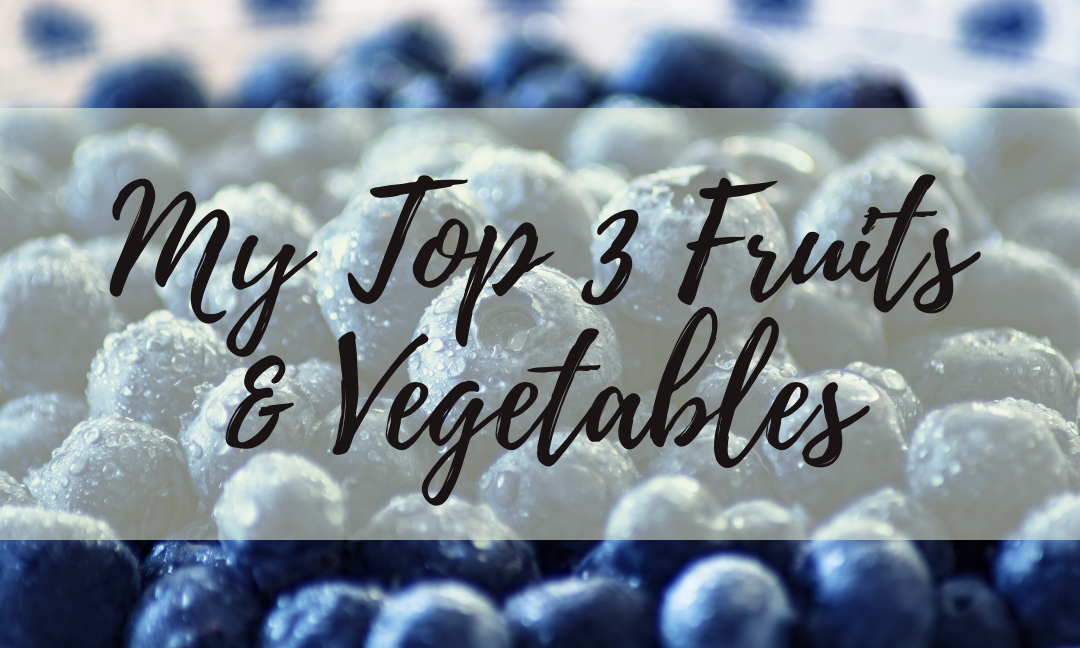
It is appropriate time to make a few plans for the future and it is time to be happy. I have learn this publish and if I may just I desire to suggest you few attention-grabbing issues or advice. Perhaps you could write subsequent articles regarding this article. I wish to read more issues approximately it!|
It’s not my first time to visit this site, i am browsing this web site dailly and take fastidious information from here daily.|
Do you mind if I quote a couple of your articles as long as I provide credit and sources back to your blog? My blog site is in the exact same area of interest as yours and my visitors would genuinely benefit from some of the information you provide here. Please let me know if this okay with you. Cheers!|
Hi there, sorry for the late reply! Yes, you are more than welcome to utilize anything found on the blog here, with credit. Thanks for visiting!
Good blog you have here.. It’s difficult to find high quality writing like yours nowadays. I really appreciate individuals like you! Take care!!|
Every weekend i used to pay a quick visit this web site, as i want enjoyment, for the reason that this this site conations actually nice funny material too.|
I wanted to thank you for this wonderful read!! I absolutely loved every bit of it. I have got you saved as a favorite to check out new things you post…|